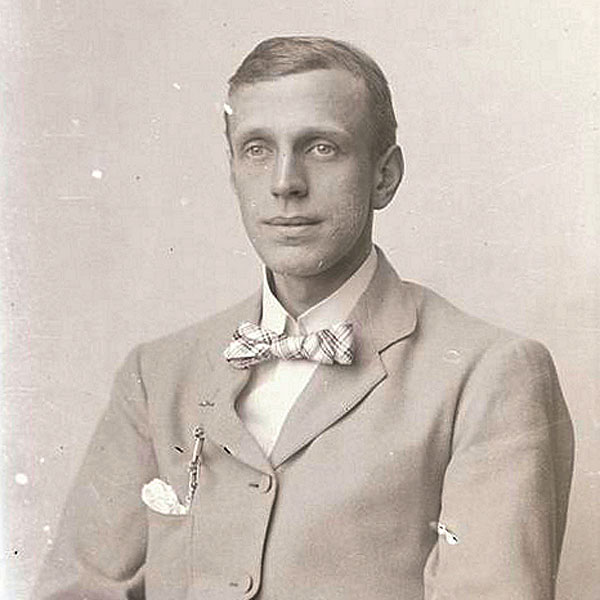William Storr-Barber, 1876–1934
Sculptor
William Storr-Barber was an acclaimed sculptor and mason.
He designed the war memorial in Leominster and over 20 other memorials in the Borders.
His masterpiece was a complex reredos filling the width of the chancel in Mitcheldean Church in the Forest of Dean. He made the statue in the niche of the Catholic Church in Bargates.

William George Barber was the first child of the Revd. George Richard Barber, a Congregational minister of Castle Camps, Cambridgeshire, and his wife Martha. When George’s health began to fail the family moved to Soham, Cambridgeshire, where he died in 1878.
Martha was a Quaker and while on mission to Radnorshire she met Edwin Storr, and they were married in the Wesleyan Methodist Chapel in Saffron Walden, Essex in the summer of 1880. In 1883 or 4 the family moved to Leominster where Edwin opened a draper’s shop in Corn Square. Martha died in childbirth in 1886.
After attending a Quaker school William returned to Herefordshire to take up an apprenticeship with Alfred Ursell, a sculptor and monumental mason in Ross-on-Wye. When he was 21 he left Ross to study at the Aston Art School, Birmingham, and then moved to London, finding work and tuition with established sculptors.
While in London William married Florence Jay, the daughter of John Jay, builder and monumental mason of Leominster. The couple began married life in Cheltenham, while William studied at the Cheltenham School of Art. At about this time William adopted his stepfather’s name, and the whole family became Storr-Barber. The family moved back to Leominster, living in Bargates and working from a mason’s yard in Etnam Street.
William was busy. He opened a new yard in Etnam Street as well as his studio at the top of Bargates. He was commissioned by Theodore Neild, a Quaker and academic, to restore the woodwork on the Grange Court following a fire in 1909. The following year Storr-Barber completed a statue of St. Ethelbert, to be placed in an empty niche left when the Catholic Church was built in Bargates in 1888.
William now embarked on his most ambitious project; a reredos to be placed in the chancel of the church in Mitcheldean in memory of a local surgeon, Herbert Fitzherbert Jones. The result was a scene 18 ½ feet across covering the entire width of the chancel.
William was also active in this period on other artistic endeavours. He won poetry, essay and elocution competitions at Eisteddfodau at Kingsland and elsewhere, and his work in ‘modern art’ featured in a collection at Wigmore. He acted in, and produced, many plays to great acclaim.
Despite his Quaker background William volunteered to join the Royal Marines on in the latter part of the Great War, but did not see foreign service. At the end of the war he was commissioned to design and build the Royal Marines war memorial on Plymouth Hoe. Returning to Leominster he spent the next 7 years producing 28 war memorials in Herefordshire, Shropshire and Cambridgeshire, as well as working on many other commissions. He designed the war memorial in Leominster.
In the late 1920s Williams’s health began to fail, possibly as a result of his work with stone. The family moved first to Hereford and later to Kent, where he died in 1934.

